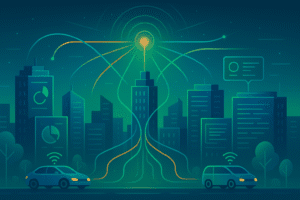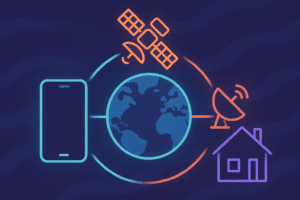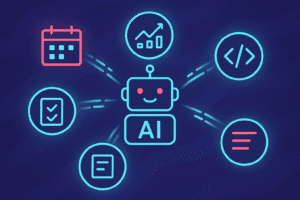The Environmental Cost of AI: Are Tech Giants Doing Enough?
Artificial intelligence is rapidly reshaping our world, from how we work to how we interact with technology. But behind the curtain of these powerful algorithms lies a growing concern: the significant environmental cost of AI. The massive data centers that power AI consume vast amounts of energy and water, and the production of specialized hardware leaves a substantial footprint.
This raises a critical question: as we race towards a more AI-driven future, are the tech giants at the forefront of this revolution doing enough to address its environmental impact?
The Hidden Power Drain of Artificial Intelligence
The primary environmental concern with AI is its enormous appetite for electricity. Training a single large AI model can consume an astonishing amount of power. For perspective, training a model like OpenAI’s GPT-3 can use nearly 1,300 megawatt-hours (MWh) of electricity, which is enough to power over 100 U.S. homes for an entire year.
This energy consumption happens in two main phases:
- Training: This is the most energy-intensive part, where models are fed massive datasets to learn and develop their capabilities. It requires thousands of powerful processors running continuously for weeks or even months.
- Inference: This is the energy used when we interact with AI—asking a question, generating an image, or getting a recommendation. While a single query uses a small amount of energy, the billions of daily interactions add up to a significant global energy demand.
The International Energy Agency (IEA) has projected that electricity consumption from data centers, driven heavily by AI and cryptocurrency, could double by 2026. This surge in demand puts immense pressure on electricity grids and can lead to an increased reliance on fossil fuels if not managed with renewable energy sources.
Data Centers: Thirsty for More Than Just Power
Beyond electricity, AI has a significant water footprint. Data centers generate immense heat, and water is the most common method for cooling the powerful servers within them.
A single data center can consume millions of gallons of water per day, often drawing from local municipal supplies. For example, Google reported consuming 5.6 billion gallons of water in 2022, a significant portion of which was for its data centers. This can create a strain on water resources, especially in regions already facing water scarcity. The process of making AI “smart” through training is particularly thirsty. Research has estimated that training GPT-3 in Microsoft’s U.S. data centers may have consumed 700,000 liters (about 185,000 gallons) of fresh water.
The Hardware Footprint: From Mining to E-Waste
The environmental cost of AI isn’t limited to its operational phase. The entire lifecycle of AI hardware, from creation to disposal, has an impact.
AI models rely on specialized, high-performance hardware like Graphics Processing Units (GPUs) and Tensor Processing Units (TPUs). The manufacturing of these components is resource-intensive, requiring the mining of rare earth metals such as lithium, cobalt, and nickel. These mining operations are often associated with deforestation, water pollution, and high carbon emissions.
Furthermore, the rapid pace of AI development leads to a short lifespan for this hardware. As newer, more powerful chips are released, older models become obsolete, contributing to the growing problem of electronic waste (e-waste). This e-waste contains toxic materials that can harm the environment if not disposed of or recycled properly.
What Are Tech Giants Doing About It?
The major players in the AI space—Google, Microsoft, Amazon, and Meta—are not ignorant of these issues. They are some of the largest corporate buyers of renewable energy and have all made public commitments to sustainability.
Pledges and Progress
- Google has been carbon neutral since 2007 and aims to run on carbon-free energy 24/7 by 2030. They are also investing in water-efficient cooling technologies for their data centers. You can read more about their efforts in their latest environmental report.
- Microsoft has pledged to be carbon negative, water positive, and zero waste by 2030. However, their recent reports have shown a significant increase in both carbon emissions and water consumption, largely driven by their AI expansion. More details are available in their sustainability reports.
- Amazon Web Services (AWS), a dominant force in cloud computing, is the world’s largest corporate purchaser of renewable energy and is committed to powering its operations with 100% renewable energy by 2025.
Is It Enough?
Despite these commitments, the reality is that the explosive growth of AI is outpacing many of their sustainability gains. Microsoft’s emissions, for example, jumped by nearly 30% since 2020, a trend they directly link to the construction of more data centers for AI.
Critics argue that while long-term renewable energy goals are commendable, they don’t fully address the immediate and localized impacts of data centers on power grids and water supplies. There is also a call for greater transparency, as companies are often not required to disclose the full environmental impact of their AI products.
Charting a More Sustainable Path
Addressing the environmental cost of AI requires a multi-faceted approach. Tech companies bear a significant responsibility, but researchers, policymakers, and users also have a role to play.
| Stakeholder | Potential Actions |
|---|---|
| Tech Companies | Invest in more efficient AI models (smaller is better). Power data centers directly with 24/7 carbon-free energy. Increase transparency on energy and water usage per service. |
| AI Researchers | Develop less resource-intensive algorithms and training methods. Create standardized metrics for measuring the environmental impact of models. |
| Policymakers | Implement regulations requiring environmental impact reporting for large-scale AI. Incentivize the construction of green data centers. |
| Users | Be mindful of AI usage. Support companies that demonstrate a strong commitment to sustainability and transparency. |
Looking Ahead
The conversation around AI is often dominated by its incredible potential and ethical dilemmas. However, its environmental impact is a tangible and urgent issue that cannot be overlooked.
While tech giants are taking steps in the right direction with renewable energy investments and efficiency research, the sheer scale and speed of AI development are creating a massive environmental challenge. True progress will require a fundamental shift where sustainability is not just an add-on but a core principle in the design and deployment of artificial intelligence. The future of AI and the health of our planet depend on it.
Share this post:














Post Comment